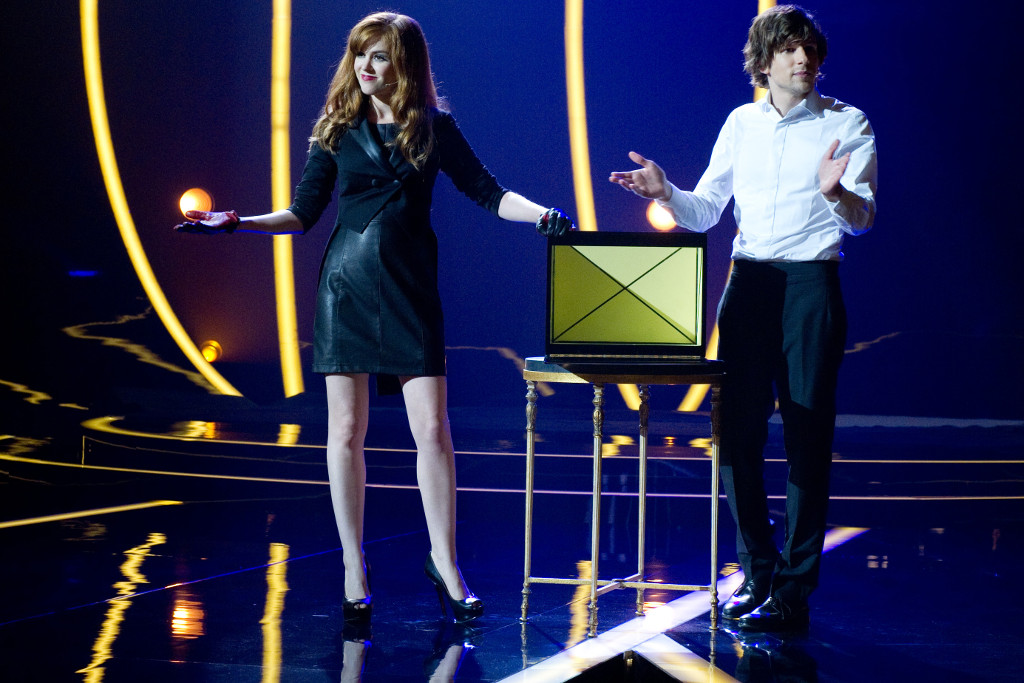Now You See Me, And Other Dubious Examples Of Magic In The Movies
From Georges Melies to Jesse Eisenberg, we call bullshit.

Early word from the US is calling shenanigans on the new film release, Now You See Me.
The film — which features Jesse Eisenberg, Isla Fisher, Woody Harrelson, and Franco the Younger (ie: Dave) as stage magicians who also moonlight as heist thieves (as any magician would) — is drawing flack for eschewing the traditional arts of sleight of hand stage magic in favour of bouts of Computer Generated Imagery to depict the characters’ illusions. The trailer, in which Fisher and friends take a running jump off a skyscraper and dissolve their corporeal forms into drifting clouds of cold hard cash, offers a pretty clear example.
Can a magic trick really satisfy when it’s made in a camera or a computer? Why should we be wowed by these tricks when they’re not even possible to perform? Is impossible even a thing, when we’re talking about magic?
The on-screen line between stage magic and what we might shudder to hear Gene Shalit call ‘movie magic’ has long been a fine one, going all the way back to the work of early French cinema and special effects pioneer, Georges Méliès. Follow along now, as we get all Houdini-in-a-straitjacket and attempt to untangle the ins-and-outs of magic in cinema.
–
Georges Méliès – Prolific Magic Egg (1903)
Méliès was the original granddaddy of magic in cinema, turning to film as a continuation of his earlier career as an illusionist. Here he amazes and confounds by doing all sorts of things to transmogrify a simple egg. (Don’t adjust your computers; it is a real-life silent film.)
But is it stage magic or movie magic? Movie magic. This hews pretty closely to the tradition of stage magic, but is a good example of the kind of cinematic tricks that defined early special effects, and are still used today. There’s a lot of almost seamless cutting and crossfading that allows Méliès to elide the moments when he switches one object out for another, a neat bit of audience misdirection that actually completely eliminates the need to direct their attention elsewhere.
–
Hugh Jackman – The Prestige (2006)
Semi-forgotten in the wake of Christopher Nolan’s nerd-devouring blockbusters, his palate cleansing follow-up to 2005’s Batman Begins is actually kind of a gem, following the lifetime rivalry between two dueling magicians who each seek to upstage and steal the others’ tricks. Here, Robert Angier (Jackman) demonstrates his showstopper ‘The Transported Man’, a concept he stole from his rival Alfred Borden (Christina Bale) but which he went to dark lengths to perfect.
But is it stage magic or movie magic? Movie magic. Nolan usually eschews the excesses of CGI spectacle in favour of practical effects, and he delivers this particular illusion with the aid of some low-key cinematic tricks. The lightning bolts generated by Angier’s contraption are obviously animated, but, much as in Melies’ work, the coup de grace is achieved through a simple edit. In one shot, Jackman is on stage, and in the next, he’s on the theatre balcony. I don’t think Hugh Jackman can really teleport.
–
Orson Welles – Follow The Boys (1944)
In this 1944 Universal Pictures musical, made to entertain American troops abroad, Orson Welles plays himself, demonstrating a few selections from his magic show with the help of Marlene Dietrich. Marvel and be amazed as he lazily hangs back for a smoke while two men saw Dietrich in half. He also contrives to lob live, crazed birds and rabbits at his unprepared audience.
But is it stage magic or movie magic? Both, I guess? Welles was actually a pretty good magician, and he took a similar stage show on the road to perform for troops around this time with his wife Rita Hayworth as his assistant. But it’s hard to distinguish how much of the magic here is genuine and what’s done in camera: some tricks certainly look like they could be achieved on stage — you can sort of see the wire on the floating cigar — but others seem to be created in the editing suite. Embrace the mystery.
–
Ricky Jay – The Ranger, The Cook And A Hole In The Sky (1995)
In this 1995 TV movie, Ricky Jay demonstrates some basic card-trickery, casually pulling out the aces as he shuffles the deck. Vintage pre-Sliders Jerry O’Connell does his best to seem naive and amazed.
But is it stage magic or movie magic? Stage magic. Ricky Jay is a real magician and performs real magic (duh), and the film lets him show his stuff without any cinematic interference. The camera hangs back in an awkwardly staged long take and lets Jay’s hands do all the work. Jay is also a deadly master (or “Leading Hurler of Martial Projectiles”) when it comes to card throwing, so you wouldn’t want to be caught disputing the craft behind his tricks, anyway.
–
Now You See Me opens in cinemas nationally today.
–
James Robert Douglas is a freelance writer and critic in Melbourne. His work has been found in The Big Issue, Meanland, Screen Machine, and the Meanjin blog. He tweets from @anthroJRD